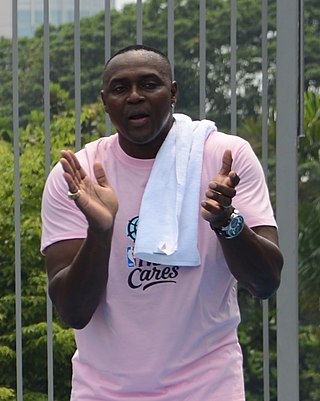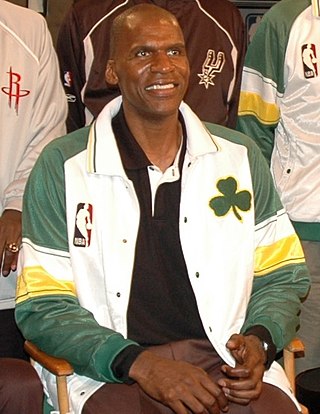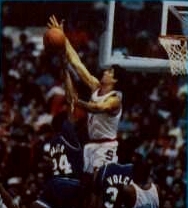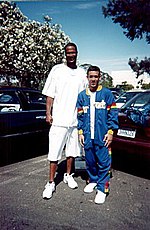
The Golden State Warriors are an American professional basketball team based in San Francisco. The Warriors compete in the National Basketball Association (NBA) as a member of the Pacific Division of the Western Conference. Founded in 1946 in Philadelphia, the Warriors moved to the San Francisco Bay Area in 1962 and took the city's name, before changing its geographic moniker to Golden State in 1971. The club plays its home games at the Chase Center.

Horace Junior Grant Sr. is an American former professional basketball player who is a special advisor for Michael Reinsdorf, the president and chief operating officer of the Chicago Bulls. He played college basketball at Clemson University before playing professionally in the National Basketball Association (NBA), where he became a four-time champion; winning three championships with the Chicago Bulls and one championship with the Los Angeles Lakers. Horace is the twin brother of former NBA player Harvey Grant.

Christopher Paul Mullin is an American former professional basketball player, executive and coach. He is a two-time Olympic Gold medalist and a two-time Naismith Memorial Basketball Hall of Fame inductee.

Timothy Duane Hardaway Sr. is an American former professional basketball player. Hardaway played in the National Basketball Association (NBA) for the Golden State Warriors, Miami Heat, Dallas Mavericks, Denver Nuggets and Indiana Pacers. He was a five-time NBA All-Star and All-NBA Team selection. Hardaway won a gold medal with the United States national basketball team at the 2000 Summer Olympics. He was known for his crossover dribble which was dubbed the "UTEP two-step" by television analysts. In 2022 Hardaway was inducted into the Naismith Memorial Basketball Hall of Fame.

William Mark Price is an American former basketball player and coach. He was most recently the head coach of the Charlotte 49ers. As a player, he played for 12 seasons in the National Basketball Association (NBA), from 1986 to 1998. Spending the majority of his career with the Cleveland Cavaliers, his last three years consisted of one season each with the Washington Bullets, Golden State Warriors, and Orlando Magic.

Donald Arvid Nelson is an American former professional basketball player and head coach. Nelson is second all-time in regular season wins of any coach in NBA history, with 1,335. He coached the Milwaukee Bucks, the New York Knicks, the Dallas Mavericks, and the Golden State Warriors. After an All-American career at the University of Iowa, Nelson won five NBA championships playing with the Boston Celtics, with his number 19 retired by the franchise in 1978.

Robert Lee Parish is an American former professional basketball player. A 7'1" center, Parish played for four teams in the National Basketball Association (NBA) from 1976 to 1997. During his 14-year tenure with the Boston Celtics, Parish teamed with Hall-of-Fame forwards Larry Bird and Kevin McHale to form one of the greatest front lines in NBA history.

Mitchell James Richmond III is an American former professional basketball player. He played collegiately at Moberly Area Community College and Kansas State University. He was a six-time NBA All-Star, a five-time All-NBA Team member, and a former NBA Rookie of the Year. In 976 NBA games, Richmond averaged 21.0 points per game and 3.5 assists per game. Richmond was voted into the Naismith Memorial Basketball Hall of Fame in 2014. His jersey No. 2 was retired in his honor by the Sacramento Kings, for whom he played seven seasons.

Ronald Fred Seikaly is a Lebanese and American former professional basketball player. Seikaly was one of the first internationally born players to make an impact on American basketball. He was considered one of the top college players from the Syracuse basketball program, Seikaly's stellar offense and defense placed him among the school's all-time leaders in rebounds, points and blocks, while earning several nationally recognized awards and honors. His number 4 jersey was retired by Syracuse and raised to the rafters of the Carrier Dome. Drafted into the National Basketball Association (NBA) by the Miami Heat with the 9th pick of the 1988 draft and the first ever pick for the Heat, Seikaly developed into one of the best centers in the NBA and the team's top offensive and defensive contributors–winning NBA player of the week twice–and also amassing many of the team's records . Seikaly earned the 1990 NBA Most Improved Player Award and later played for the Golden State Warriors, Orlando Magic and New Jersey Nets and in Spain with FC Barcelona. He was also part of the United States national basketball team during the 1986 FIBA World Championship, winning gold. After his retirement from basketball, Seikaly became a successful real estate developer. He also works in electronic music as a producer/DJ, and hosted a radio show, Sugar Free Radio, on Sirius/XM.
The 1991 NBA draft took place on June 26, 1991, in New York City, New York. Larry Johnson was selected first overall; he won the 1992 NBA Rookie of the Year award and as a two-time All-Star, was the first player to represent the Charlotte Hornets franchise at an All-Star game.
Anthony Eugene Peeler is an American former professional basketball player, having played for a number of National Basketball Association (NBA) teams from 1992 to 2005. He was most commonly known for his defense and athleticism. He later became an assistant coach at NCAA Division II Virginia Union University.
The 1991–92 NBA season was the 46th season of the National Basketball Association. The season ended with the Chicago Bulls winning their second straight NBA Championship, beating the Portland Trail Blazers 4 games to 2 in the NBA Finals. This would be Larry Bird's final season in the NBA.
Nellie Ball is an offensive strategy in basketball developed by NBA head coach Don "Nellie" Nelson. It is a fast-paced run-and-gun offense relying on smaller, more athletic players who can create mismatches by outrunning their opponents. A true center is usually not needed to run this type of offense. A large volume of three-point attempts is also a feature of Nellie Ball. This offense is most effective against teams that do not have the athleticism or shooting ability to keep up with the fast pace.
The 1966–67 season of the Philadelphia 76ers was their 14th season in the National Basketball Association (NBA) and their 4th since moving from Syracuse.
The 1990–91 NBA season was the Warriors' 45th season in the National Basketball Association, and 28th in the San Francisco Bay Area. The trio of Chris Mullin, Mitch Richmond, and second-year star Tim Hardaway were given the name "Run TMC" during the season. In the opening game, the Warriors defeated the Denver Nuggets 162–158, the highest-scoring regulation game in NBA history. Despite their scoring prowess, the Warriors were limited defensively. The team got off to a solid start winning seven of their first nine games, but later on played around .500 along the way. On February 26, 1991, they lost 131–119 to the Orlando Magic despite the Run TMC trio each scoring more than 30 points. At midseason, the team signed rookie guard Mario Elie after a brief stint with the Philadelphia 76ers. The Warriors held a 26–20 record at the All-Star break, and won their final five games of the season, finishing fourth in the Pacific Division with a 44–38 record.
The 1991–92 NBA season was the Warriors' 46th season in the National Basketball Association, and 29th in the San Francisco Bay Area. On the first day of the regular season, Run TMC was broken up when the Warriors traded star guard Mitch Richmond to the Sacramento Kings in exchange for top draft pick, and 6' 8" Syracuse forward Billy Owens, who was selected 3rd overall by the Kings in the 1991 NBA draft. Owen's additional height compared to Richmond's 6' 5" height was the size that head coach Don Nelson believed would complete the team. Nelson said he "was under pressure to get [the team] bigger" to improve the Warriors from a good team to a great one. "I’d never make that trade again", Nelson lamented. The Warriors started their season winning their first four games, then won 11 of their 15 games in February including an 8-game winning streak. The team held a 29–15 record at the All-Star break, and finished second in the Pacific Division with a 55–27 record, the most wins in a season for the franchise since 1975–76.
The 1991–92 NBA season was the Kings' 43rd season in the National Basketball Association, and seventh season in Sacramento. The Kings had the third overall pick in the 1991 NBA draft, and selected Billy Owens out of Syracuse University, but later on traded him to the Golden State Warriors in exchange for Mitch Richmond before the start of the season. The team also acquired Spud Webb from the Atlanta Hawks during the off-season, and traded Bob Hansen to the Chicago Bulls in exchange for Dennis Hopson early into the season. However, their struggles continued as the Kings road losing streak climbed up to 43 consecutive road losses before defeating the Orlando Magic 95–93 at the Orlando Arena on November 23. The Kings would change coaches again firing Dick Motta after a 7–18 start to the season. However, under his replacement Rex Hughes, the Kings went on a 10-game losing streak in March, finishing last place in the Pacific Division with a 29–53 record.
The 1989–90 NBA season was the Warriors' 44th season in the National Basketball Association, and 27th in the San Francisco Bay Area. With the 14th pick in the 1989 NBA draft, the Warriors selected Tim Hardaway from the University of Texas-El Paso. Hardaway teamed with All-Star forward Chris Mullin, and second-year star Mitch Richmond to form the threesome later known as Run TMC. The Warriors got off to a bad start losing 14 of their first 18 games, but posted two six-game winning streaks afterwards winning 12 of their next 15 games, and held a 23–24 record at the All-Star break. At midseason, the team traded Winston Garland to the Los Angeles Clippers. However, midway through the season, they struggled and fell below .500, missing the playoffs by finishing fifth in the Pacific Division with a 37–45 record.

Run TMC was the high-scoring trio of Hall of Fame basketball teammates consisting of Tim Hardaway, Mitch Richmond and Chris Mullin. Starting in 1989, they played together for two seasons with the Golden State Warriors in the National Basketball Association (NBA). Coached by Don Nelson, who was also inducted into the Hall of Fame, the Warriors played a fast-paced, run-and-gun style, and Run TMC was the league's highest-scoring trio in the 1990–91 season. Despite their short time together, the popularity of Run TMC endured. Their name was a play on the hip hop group Run-DMC, with the first name initials of each member forming TMC.









